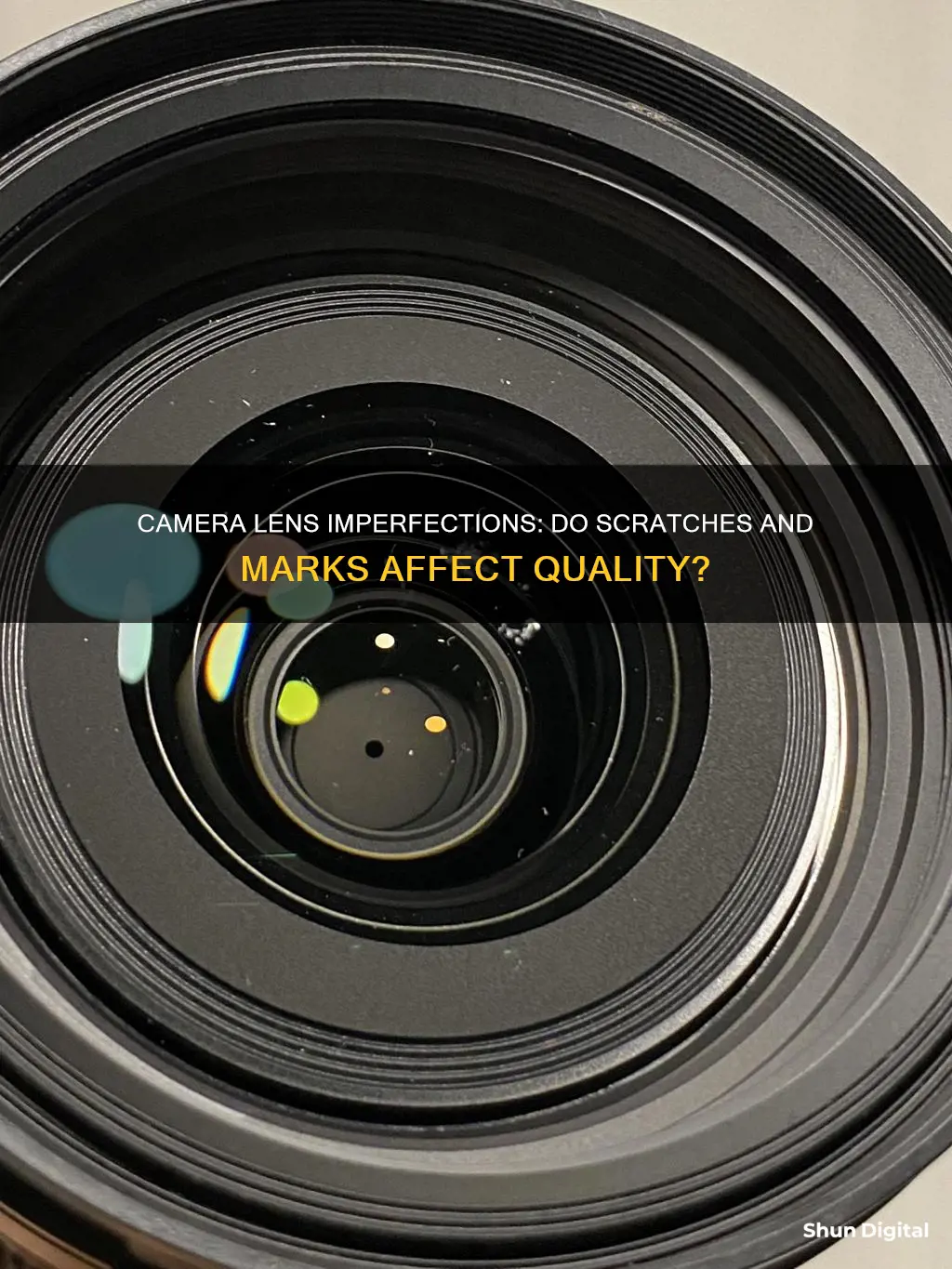
Scratches on camera lenses are a common concern for photographers, especially those using expensive equipment. While it is generally recommended to keep lenses scratch-free, the impact of minor scratches on image quality is often debated. Some claim that scratches can reduce contrast and sharpness, while others argue that the effects are negligible unless the scratch is significant.
To investigate this topic, several experiments have been conducted. One approach involved intentionally scratching lenses with a Dremel tool and evaluating the resulting images. Another method was to compare images taken with scratched and pristine lenses side by side. These studies concluded that while scratches may cause a slight reduction in contrast and sharpness, the impact is usually unnoticeable unless the scratch is large or located near the focal plane. Additionally, scratches can make lens flares more noticeable.
To protect lenses from scratches, photographers often use UV filters or lens hoods. While UV filters are designed to shield the lens from scratches, some argue that they can also negatively affect image quality. Lens hoods, on the other hand, provide protection by recessing the lens and shielding it from collisions.
In conclusion, while scratches on camera lenses are undesirable, their impact on image quality is typically minimal for small scratches. Photographers should still take precautions to protect their lenses, but minor scratches are unlikely to ruin images.
| Characteristics | Values |
|---|---|
| Scratches on camera lenses | Reduce the contrast and sharpness of images |
| Almost exclusively at the point where the scratch is on the element | |
| More noticeable at higher aperture values | |
| Can be more visible when there is a flare in the image | |
| Can be filled in with a black sharpie to reduce glare |
What You'll Learn
- Scratches on camera lenses will reduce the contrast and sharpness of your images
- The effect of scratches is inversely proportional to focus distance
- The effect of scratches depends on the location of the scratch and the type of lens
- Dirt, debris, and damage will be most evident when it’s closest to the focal plane (sensor)
- A lens hood is an effective way to protect your lens from colliding with objects

Scratches on camera lenses will reduce the contrast and sharpness of your images
Scratches on the front element of a camera lens will reduce the contrast and sharpness of your images. The effect of scratches depends on their size and location. Larger scratches that are closer to the centre of the lens or the focal plane will be more noticeable. Similarly, scratches will be more apparent when the aperture is higher (e.g. f/16) than when it is lower (e.g. f/2.8).
In general, scratches will be most evident when they are closest to the focal plane (sensor). At lower aperture values (e.g. f/1.4, f/2.8, or f/3.5), a front element scratch will be almost impossible to detect. However, dust or damage on the sensor or the rear element of the lens will appear as a small shadow or a blurry artifact.
Stopping down the aperture will also contribute to the visibility of scratches. For example, a scratch on a front element may be unnoticeable at f/2.8 but may appear as a localized haze or blur at f/16.
The impact of scratches also depends on the type of lens. Scratches on wide-angle lenses are more noticeable than those on telephoto lenses. This is because each square millimetre of the front element of a wide-angle lens is responsible for only a tiny section in the final image. Therefore, scratches cause more localised image quality damage. Conversely, telephoto lenses capture images using almost the entire front element, so scratches are less noticeable.
In addition to affecting image contrast and sharpness, scratches can also cause more lens flare.
Stabilization in Camera Lenses: How Does It Work?
You may want to see also

The effect of scratches is inversely proportional to focus distance
Scratches on the front element of a lens will reduce the contrast and sharpness of your images. However, the effect of scratches is inversely proportional to focus distance. The farther you focus, the more out of focus the ill-effects would be.
The impact of a scratch is roughly proportional to its size divided by the area of the entrance pupil. Long, fast lenses are more or less immune to all but the most horrible damage. A 12mm wide-angle lens at f/16 only has a 3/4mm entrance pupil, which means that just about any surface defect will show up, especially if it acts as a source of flare.
The effect of scratches also depends on the location of the scratch and the type of lens. It will certainly be visible on some zooms. The farther a scratch is from the centre of the lens, the less noticeable it will be.
Stopping down the aperture also contributes to the visibility of scratches. For example, a front element scratch may be impossible to spot at F2.8 but appear as localized haze or blur at F16.
The effect of scratches is also more noticeable when dealing with lens flare.
Polarized Lenses vs UV Camera Filters: What's the Difference?
You may want to see also

The effect of scratches depends on the location of the scratch and the type of lens
The effect of scratches on a camera lens depends on the location of the scratch and the type of lens.
A scratch on the front element of a lens will reduce the contrast and sharpness of your images, but only at the point where the scratch is located. The effect of scratches is inversely proportional to focus distance. The farther you focus, the more out of focus the ill-effects would be. In general, dirt, debris, and damage will be most evident when it’s closest to the focal plane (sensor). At lower aperture values (e.g. f/1.4, f/2.8, or f/3.5), a front element scratch will be almost impossible to detect, and dust or damage on the actual sensor (or on the rear element of the lens) will appear as a small shadow or possibly a blurry artifact.
At higher aperture values (e.g. f/16, f/20, f/22), a front element scratch may be a bit more noticeable, appearing as a place with less contrast and hazier. A rear element scratch or sensor scratch will be much more apparent at higher apertures, appearing as a flare, or in some cases, even a black blob.
The effect of scratches also depends on the focal length of the lens. The longer the focal length, the less noticeable the scratches will be. For example, a 2mm scratch on a Canon 17mm lens would be visible in just about any photo, whereas a 600mm lens could have a coin-sized sticker on the front element and still operate normally.
Additionally, the effect of scratches depends on the lighting conditions. Scratches are mostly invisible unless you put the sun in the frame or create lens flares.
Double Lens Cameras: More Accurate or Just a Gimmick?
You may want to see also

Dirt, debris, and damage will be most evident when it’s closest to the focal plane (sensor)
Dirt, debris, and damage to a camera lens will be most evident when it is closest to the focal plane (sensor). At lower aperture values (e.g. f/1.4, f/2.8, or f/3.5), a scratch on the front element will be almost impossible to detect, and dust or damage on the sensor (or on the rear element of the lens) will appear as a small shadow or a blurry artifact.
At higher aperture values (e.g. f/16, f/20, f/22), a scratch on the front element may be a bit more noticeable, appearing as a place with less contrast and haziness. A scratch on the rear element or a scratch on the sensor will be much more apparent at higher apertures, appearing as a flare or, in some cases, a black blob.
The impact of a scratch is roughly proportional to its size divided by the area of the entrance pupil. Long, fast lenses are more or less immune to all but the most horrible damage. A 12mm wide-angle lens at f/16 only has a 3/4mm entrance pupil, which means that just about any surface defect will show up, especially if it acts as a source of flare.
Dirt, debris, and damage closest to the focal plane (sensor) will be most evident when shooting with a wide-angle lens. Each square mm of the front element of a wide-angle lens is responsible for only a tiny section in the final image. This is why scratches cause so much local image quality damage. For telephoto lenses, this doesn't matter as much because each front element's square mm contributes to each section in the final image. So, any scratch effects get diluted enough to become almost irrelevant.
The Truth About Camera Lenses: Glass or Plastic?
You may want to see also

A lens hood is an effective way to protect your lens from colliding with objects
Scratches on camera lenses can affect image quality, particularly when there is a strong light source. Scratches can cause lens flares, which can be distracting and make images look amateurish. They can also reduce the contrast and sharpness of images, especially at higher apertures.
While scratches may not always be noticeable, it is still important to take measures to protect your camera lens. One effective way to do this is by using a lens hood.
A lens hood is an accessory that attaches to the front of your camera lens. It serves multiple purposes, including reducing lens flare and protecting the lens from accidental damage. The hood acts as a visor, shielding the lens from unwanted light and reducing the amount of glare in your photos. This is especially useful when shooting outdoors or in bright conditions.
In addition to improving image quality, a lens hood provides an extra layer of protection for your lens. It helps safeguard the lens from accidental impacts, scratches, fingerprints, and debris. This can be particularly useful when shooting in harsh weather conditions, as the hood can protect the lens from rain, snow, and dust.
Lens hoods typically come in two shapes: cylindrical and petal (or tulip). Cylindrical lens hoods are longer and are often used with prime or telephoto lenses. Petal lens hoods, on the other hand, are shorter and have curved notches that block out light while maximizing the frame size offered by wide-angle lenses.
When using a lens hood, it is important to ensure that it is securely attached to the front of your lens. You can usually screw it on, and some lens hoods can also be mounted in reverse for more compact storage.
While lens hoods offer protection, they may not always be practical or necessary. For example, if you want to create a lens flare effect in your photos, you may choose to remove the hood. Additionally, in windy conditions, a lens hood can catch the wind and cause camera shake, resulting in blurry images.
In summary, a lens hood is a valuable accessory for any photographer. It not only improves image quality by reducing lens flare and enhancing contrast but also provides a layer of protection for your camera lens, helping to prevent scratches and other types of damage.
Handcrafted Zeiss Lenses: Precision and Artistry in Optics
You may want to see also
Frequently asked questions
Marks and scratches on camera lenses do not matter much. They will not affect the image quality unless there are many big scratches on the lens. However, it is still best to keep the camera lens clean and scratch-free as scratches may reduce the contrast and sharpness of images and make the lens more prone to flare.
You can use a UV filter or a lens hood to protect your camera lens from scratches.
You can try using a black sharpie to fill in the scratches on your camera lens. Alternatively, you can try to polish the lens but this may be risky as it may damage the lens coating.







